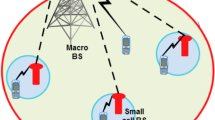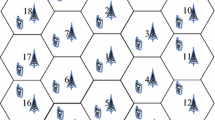Abstract
Recently, energy-efficient (EE) communications have received increasing interest specially in cellular networks. Promising techniques, such as multiple input multiple output (MIMO) and base station (BS) cooperation schemes, have been widely studied in the past to improve the spectral efficiency and the reliability. Nowadays, the purpose is to investigate how these techniques can reduce the energy consumption of the systems. In this paper, we address for a single-user scenario, the energy efficiency of two BSs cooperation under limited backhaul capacity. In order to evaluate the EE metric, we provide first an information-theoretical analysis based on the outage probability, for a quantization model over the backhaul. Then, we extend this EE analysis to a more practical approach with data transmission over the backhaul. For both approaches, we identify by numerical/simulation results the cooperation scenarios that can save energy depending on the backhaul capacity.











Similar content being viewed by others
References
3GPP TS 36.211 V8.9.0 (2009-12): 3rd Generation Partnership Project; Technical Specification Group Radio Access Network; Evolved Universal Terrestrial Radio Access (E-UTRA); Physical Channels and Modulation (Release 8) Available at: http://www.etsi.org/deliver/etsi_ts/136200_136299/136211/08.09.00_60/
Belmega EV, Lasaulce S (2009) An information-theoretic look at MIMO energy-efficient communications. Proc 4th ACM international conference on performance evaluation methodologies and tools.
Belmega EV, Lasaulce S (2011) Energy-efficient precoding for multiple-antenna terminals. IEEE Trans Signal Process 59(1):329–340
Belmega EV, Lasaulce S, Debbah M, Hjørungnes A (2009) A new energy efficiency measure for quasi-static MIMO channels. Proc. 5th ACM international conference on wireless communications and mobile computing, pp 483–488
Chen T, Kim H, Yang Y (2010) Energy efficiency metrics for green wireless communications. Proc. IEEE international conference on wireless communications and signal processing, pp 1–6
Cover TM, Thomas JA (1991) Elements of information theory, chapter 13: rate distortion theory. Wiley, New York
Energy Aware Radio and neTwork tecHnologies (EARTH). EU Funded Research Project FP7-ICT-20094- 24733-EARTH, January 2010 - June 2012. Available at:https://www.ict-earth.eu/
Fehske AJ, Marsch P, Fettweis GP (2010) Bit per joule efficiency of cooperating base stations in cellular networks. Proc IEEE Glob Commun Workshops: 1406–1411
Gesbert D, Hanly S, Huang H, Shamai Shitz S, Simeone O, Yu W (2010) Multi-cell MIMO cooperative networks: a new look at interference. IEEE J Select Areas Commun 28(9):1380– 1408
Gradshteyn IS, Ryzhik IM (1994) Table of integrals, series, and products. Academic, New York
Hamdoun H, Loskot P, O’Farrell T, He J (2012) Survey and applications of standardized energy metrics to mobile networks. Ann Telecommun 67(3–4):113–132
Holm H, Alouini M-S (2004) Sum and difference of two squared correlated Nakagami variates in connection with the McKay distribution. IEEE Trans Commun 52(8):1367– 1376
Katz M, Shamai Shitz S (2007) On the outage probability of a multiple-input single-output communication link. IEEE Trans Wirel Commun 6(11):4120–4128
Li GY, Xu Z, Xiong C, Yang C, Zhang S, Chen Y, Xu S (2011) Energy-efficient wireless communications: tutorial, survey, and open issues. IEEE Wirel Commun Mag 18(6):28–35
Marsch P, Fettweis G (2007) A framework for optimizing the downlink performance of distributed antenna systems under a constrained backhaul. Proc. European Wireless Conference, pp 1–5
Marsch P, Fettweis G (2007) A framework for optimizing the uplink performance of distributed antenna systems under a constrained backhaul. Proc. IEEE international conference on communications, pp 975–979
Marsch P, Fettweis G (2008) On base station cooperation schemes for downlink network MIMO under a constrained backhaul. Proc. IEEE global communications conference, pp 1–6
Marsch P, Fettweis G (2009) On downlink network MIMO under a constrained backhaul and imperfect channel knowledge. Proc. IEEE global communications conference, pp 1–6
Sarkiss M, Kamoun M (2012) Energy efficiency analysis of base station cooperation under limited backhaul capacity. Proc. 3rd IEEE International Conference on Communications and Networking (ComNet 2012), pp 1–8
Simeone O, Somekh O, Poor HV, Shamai S (2009) (Shitz): Downlink multicell processing with limited-backhaul capacity. IEEE Trans Info Theor 3:1–10
Simeone O, Somekh O, Poor HV, Shamai S (2009) (Shitz): local base station cooperation via finite-capacity links for the uplink of wireless networks. IEEE Trans Info Theor 55(1):190–204
Quek TQS, de la Roche G, Guvenc G, Kountouris M (2013) Femtocell networks: deployment, PHY techniques, and resource management. Cambridge University Press, Cambridge
Acknowledgments
This work was supported by the European Commission under project “Energy Aware Radio and neTwork tecHnologies” EARTH (FP7-ICT-2009-4-247733).
A part of this work is published in the IEEE 3rd International Conference on Communications and Networking (ComNet’2012) [19].
Author information
Authors and Affiliations
Corresponding author
Appendices
Appendix: A Proof of Proposition 1: rate-distortion theory
In rate-distortion theory, the quantization problem consists of representing a source X by an estimate X ̂ subject to some distortion measure or quantization error such that
For complex Gaussian source, the rate-distortion R(D) metric is defined by
It is modeled by the backward test channel
where X ̂ and Z q are independent, \(X\sim \mathcal {N}_{c}\left (0,\sigma _{X}^{2}\right )\), \(Z_{q} \sim \mathcal {N}_{c}\left (0,D=\sigma _{Z_{q}}^{2}\right )\) and \(\sigma _{\hat {X}}^2=\sigma _{X}^2-D\).
Following this model, a forward test channel can be equivalently constructed as
where X and η are independent, η being the equivalent quantization noise \(\eta \sim \mathcal {N}_{c}\left (0,\sigma _{\eta }^{2}\right )\) and c a scaling constant such that
It can be readily verified that according to this model, we have,
For our system model, BS1 quantizes X and forwards it to BS2 over the backhaul link with capacity C b . BS2 decodes then an estimate X ̂ of X with some distortion entailed by the backhaul. This distortion can be expressed in terms of the backhaul rate according to (A.2)
then we can define the forward test channel from Eqs. (A.4), (A.5) with
This concludes the Proof of Proposition 1.
B Proof of Proposition 2: difference of correlated gamma variables
As presented in [12], Type II McKay Distribution is defined as follows
Definition 3 Type II McKay Distribution
A random variable Δ follows Type II McKay distribution with parameters a > − (1 / 2), b > 0 and | c | < 1 when the PDF of Δ is
where K a (.) is the modified Bessel function of the second kind and of order a.
If X 1, X 2are two correlated Gamma variables i.e., Bivariate Gamma variables, X 1, X 2 ∼ Γ(k, θ 1, θ 2, ρ), the authors of [12] proved that their difference Δ = X 1 − X 2follows Type II McKay distribution with the parameters
where the conditions b > 0 and |c| < 1 are met as long as ρ < 1.
In the case of k = 1, \(a=\frac {1}{2}\) and this McKay distribution reduces to
Thus, it is possible to find a closed-form expression for the CDF of the McKay Type II distribution. It can be written as following
In our system model, we have Rayleigh fading channel, thus k = 1. We have also δ = λ σ 2 ≥ 0, so we can apply the second line of the CDF formula to calculate the outage probability.
This concludes the Proof of Proposition 2.
C Proof of Proposition 3: mutual information of finite constellations
The mutual information of finite constellations over Gaussian channel \(Y=\sqrt {\text {SNR}}X+Z\) is defined by
with X ∈ M-QAM, and Z the Gaussian noise Z ∼ 𝒩 c (0, N 0 with entropy given by
On the other hand, the entropy of Y is computed as follows
Note that the third and the sixth lines follow from the fact that we have uniform probability \(p(x_i)=\frac {1}{M}\), for all symbols x i ∈ M-QAM.
Therefore, this mutual information can be represented in Fig. 12 for several M-QAM modulations, with M = 4, 16 and 64.
In order to approximate the Shannon capacity C = log2(1 + SNR), it can be noticed that for a M = 2m-QAM constellation with a rate of R = m bits/cu, a lower rate corresponding to a lower order modulation ∼ (m − 1) should be used.
For instance, we can choose for
-
4-QAM, R QAM ≤ 1. 5
-
16-QAM, R QAM ≤ 3
-
64-QAM, R QAM ≤ 5
This concludes the Proof of Proposition 3.
Rights and permissions
About this article
Cite this article
Sarkiss, M., Kamoun, M. On the energy efficiency of base station cooperation under limited backhaul capacity. Ann. Telecommun. 69, 539–551 (2014). https://doi.org/10.1007/s12243-013-0401-8
Received:
Accepted:
Published:
Issue Date:
DOI: https://doi.org/10.1007/s12243-013-0401-8





